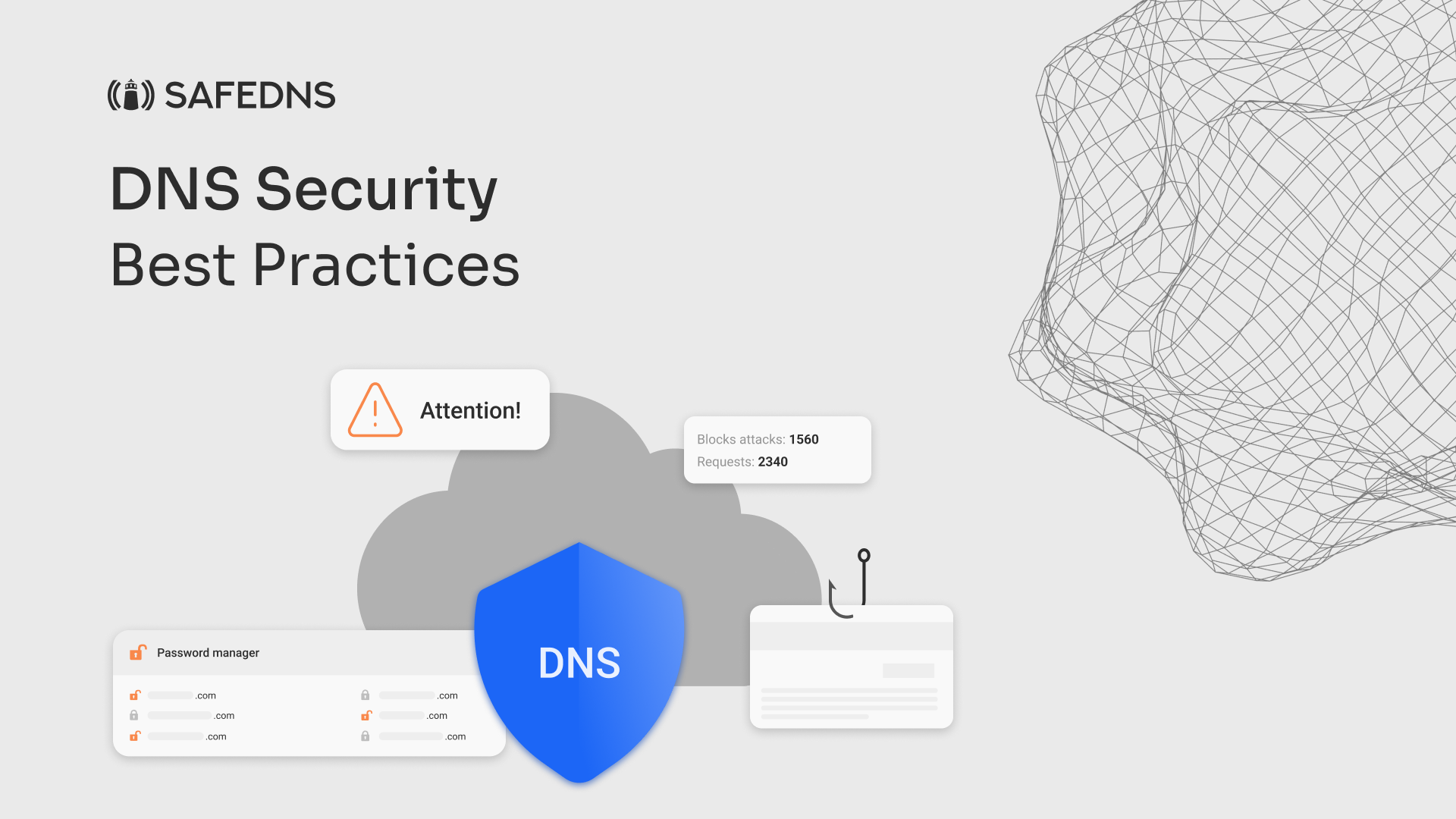
DNS Security Best Practices
DNS security, often referred to as DNSSEC (Domain Name System Security Extensions), is a set of protocols and techniques designed to protect the DNS from various threats and vulnerabilities. The primary goal of DNS security is to ensure the integrity, authenticity, and confidentiality of DNS data. By doing so, it helps prevent malicious activities such as DNS spoofing, cache poisoning, and man-in-the-middle attacks that can redirect users to fake websites or compromise their data.
Why DNS Security Is Important
DNS security is vital for preventing disruptions in operations. Any disruption to a business's online presence can have devastating consequences. DNS attacks, such as DDoS attacks or cache poisoning, can render websites and services inaccessible. DNS security measures, including robust DNS hosting and protection, mitigate these risks, ensuring uninterrupted operations and customer access to primary and secondary DNS servers. Moreover, DNS security protects sensitive data. DNS queries contain sensitive information about the websites users intend to visit, and without adequate security, these queries can be intercepted by malicious actors. Implementing DNS security ensures the confidentiality of DNS data, and protects user privacy.
Without DNS security, there are risks of phishing and fraud. Cybercriminals often use DNS to conduct phishing attacks. Malicious actors create deceptive websites with domain names similar to legitimate ones, tricking users into revealing personal information. DNS security measures help detect and block these fraudulent domains, reducing the risk of phishing and fraud incidents.
In addition, many industries and jurisdictions have specific regulations and compliance requirements related to data protection and cybersecurity. Implementing DNS security measures can help companies meet these legal obligations and avoid enormous fines for non-compliance related to IP addresses and DNS settings.
DNS Security Best Practices
Log all DNS activities: Maintain detailed logs of DNS queries and responses to monitor for suspicious activities and troubleshoot issues effectively. Analyze these logs regularly to detect security vulnerabilities and respond to potential threats. Regularly analyzing the logs allows you to detect patterns indicative of security vulnerabilities or potential threats related to both internal DNS servers and external DNS servers. Consider implementing log rotation and storage policies to manage log volumes effectively, ensuring that historical data is available when needed.
Keep the DNS cache locked: Make sure that cached data in your DNS server is secure and not vulnerable to cache poisoning attacks. Employ techniques such as implementing Source Port Randomization (SPR) and using DNS Response Rate Limiting (RRL) to mitigate the risk of cache poisoning and to filter DNS requests. Regularly audit and purge the cache to remove stale or potentially compromised data. Monitor the cache's integrity and set up alerts for any suspicious activity, ensuring that only authorized personnel can access and modify the cache.
Configure access control lists (ACL) precisely: Implement strict ACLs to control which devices and networks are allowed to access and use your DNS servers, including both primary DNS servers and secondary DNS servers. Only authorized users and systems should have access to internal DNS servers. Consider implementing geo-blocking to restrict access based on geographical locations. Periodically conduct audits to ensure that the ACLs align with your organization's evolving network architecture and security policies.
Regularly update the DNS server: Keeping your DNS server software up-to-date is a fundamental aspect of DNS security and the overall health of your external and internal DNS server. Regular updates and patches address known vulnerabilities and enhance the overall security posture of your DNS infrastructure. Stay informed about the latest security advisories relevant to your specific DNS server software by subscribing to vendor notifications and security mailing lists. Develop a well-defined patch management process to streamline the timely application of updates.
Deploy dedicated DNS applications: Using dedicated DNS server software designed for security and performance ensures that your DNS infrastructure is built with the specific demands of DNS in mind. Choose reputable DNS server software such as BIND, Microsoft DNS, or others with a track record of security and reliability. Regularly update the dedicated DNS software to benefit from the latest security enhancements and features.
Implement DNSSEC (DNS Security Extensions): DNSSEC is a critical security measure that enhances the trustworthiness of DNS data. By digitally signing DNS records, ensuring data integrity and authenticity. Enforce DNSSEC for your domains to protect against DNS spoofing and cache poisoning attacks and validate DNS data integrity. Regularly review and update DNSSEC configurations, and ensure that your domain's registrar supports DNSSEC to maintain a secure chain of trust.
Mask the primary DNS server and information: Hide the identity of your primary DNS server and its version number to minimize the risk of attackers targeting known vulnerabilities in your DNS software. Consider using DNS firewall solutions to obfuscate DNS server identities and mask DNS configuration details. Regularly update and patch your DNS server software to address vulnerabilities and deter attackers who may exploit known weaknesses in outdated versions.
Time limit the recursive DNS query response: Set a time limit for how long your DNS server will spend processing a recursive query. This helps prevent your server from being tied up by malicious or excessive requests. Fine-tune these time limits based on your network's typical query patterns and adjust them as needed. Regularly analyze query response times to identify anomalies that may indicate a potential attack or infrastructure performance issues.
Facilitate random DNS socket pool utilization: Configure your DNS server to use a random selection of source ports and request IDs to make it harder for attackers to predict and spoof DNS responses. Regularly review and update these configurations to align with emerging best practices and adapt to evolving security threats.
Ensure DNS availability with adept redundancy: Implement redundant DNS servers to maintain service availability even if one server becomes compromised or goes offline. Use load balancing and failover mechanisms for seamless DNS operation. Regularly test failover procedures to ensure quick and efficient transitions in case of a server compromise or outage. Consider leveraging both geographically distributed and cloud-based DNS servers to enhance redundancy further.
Reinforce the name servers: Secure the physical and network infrastructure of your name servers. Limit physical access, use strong authentication for administrative access, and employ firewalls and intrusion detection systems, and regular security audits to fortify the overall resilience of your name server infrastructure.
Filter and Monitor DNS Traffic: Employ DNS traffic filtering to block known malicious domains and monitor DNS traffic for anomalies and suspicious patterns. Tools like DNS filtering services and intrusion detection systems can be useful for this purpose.
In addition to these best practices, it's important to stay updated on the latest DNS security threats, as this landscape evolves continuously. Regular security audits, penetration testing, and employee training can also help ensure the overall security of your DNS infrastructure.
DNS security is a critical component of a robust cybersecurity strategy. By implementing DNS security best practices, you can protect your organization's online presence, maintain user trust, and ensure the availability and integrity of your online services. Remember that security is an ongoing process, and staying vigilant against emerging threats is key to a secure DNS infrastructure.
Take advantage of the SafeDNS trial period and try all the best features

